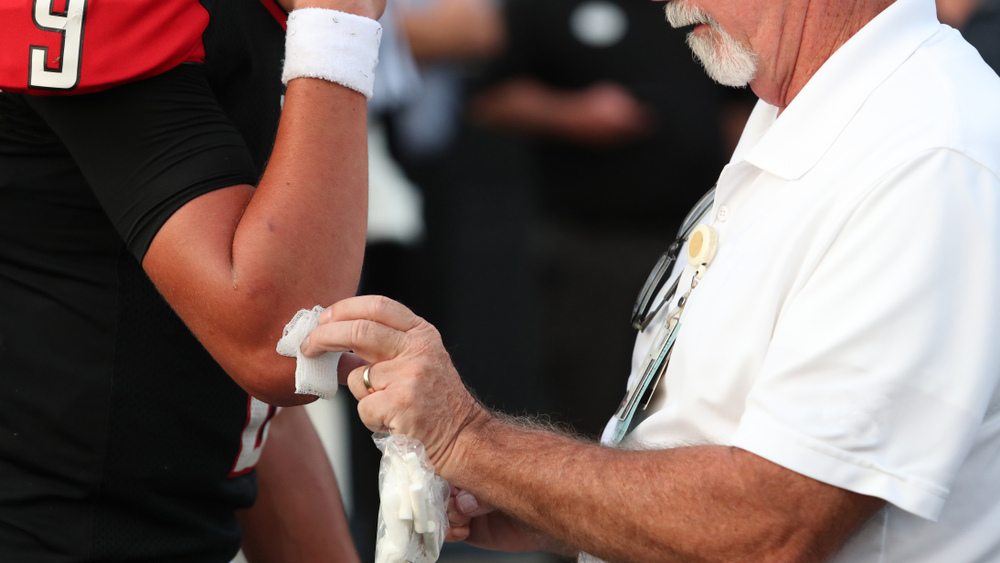
The athletic trainer role not only offers a front-row seat to the action of professional football but also demands a high level of expertise and dedication to athlete health and performance. If you’re aiming to join the elite world of NFL sports medicine, this guide lays out the crucial steps on how to become an NFL athletic trainer.
What Does an NFL Athletic Trainer Do?

NFL athletic trainers are healthcare professionals who collaborate with doctors to prevent, diagnose, and treat sports-related injuries. Their day-to-day tasks include applying protective or therapeutic devices such as tapes, bandages, and braces, recognizing and evaluating injuries, and implementing rehabilitation programs for athletes. An NFL trainer’s job is critical to maintaining player health and ensuring quick recovery.
Key Responsibilities
- Injury Prevention: Athletic trainers develop programs to keep athletes in top physical shape and minimize their risk of injuries.
- Emergency Care: They provide immediate care and coordinate emergency management when severe injuries occur.
- Rehabilitation: Trainers design and oversee rehabilitation programs to help athletes recover from injuries.
- Education and Counseling: They also educate players on nutrition, injury prevention, and techniques tailored to their individual needs and the demands of the sport.
7 Steps to Become an NFL Athletic Trainer
Let’s now break down the 7 steps on how to become an NFL athletic trainer, providing you a roadmap to reach your goals.
Step 1: Obtain a Bachelor’s Degree
Your first significant step to becoming an NFL athletic trainer is obtaining a bachelor’s degree in a field directly related to sports medicine. Here are some essential details about this crucial educational foundation:
Degree Focus
Ideal degree programs include Athletic Training, Kinesiology, Physical Therapy, or Exercise Science. These programs cover crucial subjects like anatomy, physiology, biomechanics, and nutrition, which are foundational to understanding human physical functions and sports-related injuries.
Accreditation
Ensure the program is accredited by the Commission on Accreditation of Athletic Training Education (CAATE). Accreditation ensures that the program meets the professional quality standards necessary for a career in athletic training.
Curriculum Requirements
Typical courses in an accredited athletic training program include:
- Human Anatomy and Physiology: Detailed study of the human body’s structure and function.
- Orthopedic Pathophysiology: Focuses on injuries and disorders that affect the musculoskeletal system.
- Therapeutic Modalities: Training using various physical agents (like heat, cold, and electricity) to treat injuries..
- Nutrition for Physical Activity: Covers how nutrition affects body function and performance during physical activities.
- Exercise and Sports Science: Study of the scientific principles behind exercise and its impact on the human body.
- Clinical Experience: Accredited programs require at least 1,200 hours of clinical experience under the supervision of a Certified Athletic Trainer (ATC). These hours are typically spread over different settings, including high schools, colleges, sports medicine clinics, and possibly professional sports teams.
By pursuing a bachelor’s degree with a thorough and focused curriculum, you are fulfilling an essential requirement and building a solid foundation of knowledge and skills that will be crucial as you learn how to become an NFL athletic trainer.
Step 2: Complete a Master’s Degree

Given the competitive nature of the field, particularly at elite levels such as the NFL, obtaining a master’s degree in Athletic Training, Sports Medicine, or a related field is highly advantageous. Here are detailed aspects of completing a master’s degree tailored for those learning how to become an NFL athletic trainer:
Advanced Curriculum
Master’s programs in Athletic Training and Sports Medicine build upon undergraduate knowledge and delve deeper into specialized subjects. Courses might include Advanced Clinical Diagnosis, Biomechanics, Sports-specific Rehabilitation Techniques, Leadership and Administration in Sports Medicine, and Evidence-based Practice.
Research Opportunities
Many master’s programs offer research opportunities. Use this opportunity to explore specific issues prevalent in NFL athletes, such as concussions or chronic musculoskeletal conditions, under the guidance of experienced professionals.
Internships and Practical Experience
A crucial component of a master’s program is the requirement for more extensive and often more specialized internships compared to those at the bachelor’s level. These internships might be directly with sports teams, specialized sports clinics, or athletic training facilities that focus on the types of injuries common in football players.
Networking and Professional Engagement
Master’s programs often provide platforms for attending national conferences, workshops, and seminars. These events are crucial for networking with established professionals in the field, learning from experts, and staying updated with the latest practices and technologies in athletic training.
Certification Preparation
While a bachelor’s program prepares you for initial certification, a master’s program can prepare you for advanced certifications and specializations. Certifications such as the Corrective Exercise Specialist (CES) or Performance Enhancement Specialist (PES) from organizations like the National Academy of Sports Medicine (NASM) can be pursued during or after a master’s program.
Thesis or Capstone Projects
Most programs culminate in a thesis or capstone project that allows students to apply what they have learned in a comprehensive project. For someone targeting an NFL career, this project could focus on an issue particularly relevant to football, such as improving rehabilitation outcomes for ACL injuries or developing preventative measures for common NFL injuries.
A master’s degree significantly enhances a candidate’s credentials and provides deep insights and practical skills essential for high-level positions such as an NFL athletic trainer. It sets a foundation for entry into the field and potential future leadership roles in sports medicine.
Step 3: Pass the Board of Certification (BOC) Exam
Passing the Board of Certification (BOC) exam is a critical milestone for those learning how to become an NFL athletic trainer, signifying a comprehensive understanding of the core competencies required in athletic training. Here are more insights about this essential certification process:
Exam Content and Structure
The BOC exam is meticulously designed to assess a candidate’s proficiency across several critical domains of athletic training. These include:
- Injury and Illness Prevention and Wellness Promotion: Examines knowledge of risk factors, preventive strategies, and wellness intervention.
- Examination, Assessment, and Diagnosis: Focuses on systematic evaluations, using clinical reasoning to determine appropriate interventions.
- Immediate and Emergency Care: Tests skills in providing initial care and making appropriate referrals.
- Therapeutic Intervention: Covers the rehabilitation and therapeutic modalities for returning athletes to normal activity.
- Healthcare Administration and Professional Responsibility: Evaluates understanding of administrative tasks and professional ethics.
Eligibility Requirements
Candidates must meet specific educational and clinical prerequisites:
- Completion of a CAATE-accredited program is mandatory.
- Proof of degree: Candidates need to submit their transcripts as proof of education.
- Clinical Experience Documentation: Documentation of supervised clinical experience is required, illustrating hands-on patient care.
Long-Term Certification Maintenance
Certified athletic trainers must engage in ongoing professional development to maintain their certification, including:
- Completing Continuing Education Units (CEUs): These are required every two years and must include Evidence-Based Practice (EBP) courses.
- Emergency Cardiac Care (ECC) Certification: All practicing athletic trainers must maintain current ECC certification.
Passing the BOC exam is more than just a certification step; it is a demonstration of readiness to handle the responsibilities of an athletic trainer at a professional level, including working with NFL teams where the demands and pressures are significantly higher than in many other settings.
Step 4: Obtain State Licensure
After passing the Board of Certification (BOC) exam, the next essential step for those learning to become an NFL athletic trainer is obtaining state licensure. This process varies by state, but here are detailed facts and steps commonly involved:
State-by-State Requirements
The requirements for licensure can differ significantly from one state to another. All states require passing the BOC exam, but additional requirements might include:
- Background Checks: Many states require a criminal background check as part of the licensure process.
- Jurisprudence Exam: Some states have a state-specific law exam that covers regulations and statutes relevant to practicing athletic training within that state.
- Application Fees: These vary by state but are typically required when submitting your licensure application.
Application Process
- Documentation: Applicants must typically provide documentation of their educational background, BOC certification, any prior licensures, and results from their background checks.
- Application Review: State boards review applications to ensure all requirements are met before issuing a license.
- Renewal: Athletic trainer licenses are not indefinite and must be renewed periodically (often every two years). Renewal usually requires continuing education and may sometimes require additional documentation of ongoing professional practice.
Interstate Practice
Understanding the reciprocity agreements between states is crucial for athletic trainers who may work across state lines (such as traveling with a professional sports team like the NFL). Some states have mutual recognition that allows trainers licensed in one state to practice in another without obtaining a new license.
Professional Liability Insurance
While not always a licensure requirement, carrying professional liability insurance is strongly recommended for all practicing athletic trainers. This insurance protects against legal claims related to the professional services provided.
For those learning how to become an NFL athletic trainer, meeting and maintaining these licensure requirements is essential for compliance and ensuring the highest standards of athlete care and professional practice.
Step 5: Gain Relevant Experience

When learning to become an NFL athletic trainer, gaining targeted, practical experience is crucial. Here are specific recommendations and actionable steps to acquire relevant experience in the field:
Targeted Internships
Seek internships specifically with collegiate football programs or professional sports teams with a structured relationship with the NFL, such as those participating in the NFL’s Summer Internship Program. These programs are often designed to give you direct exposure to the high demands of professional sports medicine and networking opportunities with professionals in the league.
Work with Minor Leagues or Semi-Pro Teams
Positions with minor league football teams or semi-professional sports teams can be valuable stepping stones. These roles often provide more hands-on opportunities and responsibilities earlier in your career than starting directly in the major leagues.
Clinical Experience in Relevant Settings
Aim for clinical rotations in sports medicine clinics that frequently treat athletes, especially those specializing in common football treatments such as ACL rehabilitation or concussion management.
Attend Specific Workshops and Certifications
Enhance your skills by attending workshops focusing on sports-specific injury prevention, emergency care, and recovery.
Join Sports Medicine Research Projects
Participate in or initiate research projects focusing on common football injuries, recovery protocols, or performance enhancement studies.
Seek Mentorship
Find a mentor currently working in the NFL or with previous league experience. A mentor can provide guidance and career advice and possibly advocate for you when job opportunities arise within the league.
By following these specific actions, you can build a strong portfolio of experiences and skills tailored to the demands of being an NFL athletic trainer.
Step 6: Specialize in Football-Specific Athletic Training
To excel as an NFL athletic trainer, specializing in football-specific athletic training involves targeted efforts and strategic education. Here are more detailed recommendations to further specialize in football:
Certifications Tailored to Football
Pursue additional certifications that are highly respected within the football community, such as:
- Certified Strength and Conditioning Specialist (CSCS) s issued by the National Strength and Conditioning Association and focuses on advanced strength and conditioning techniques.
- Sports Metrics Certification, specializes in injury prevention for athletes, particularly in preventing ACL injuries common in football.
- Advanced Cardiac Life Support (ACLS) certification is crucial for handling cardiac emergencies that may occur on the field.
Professional Development through PFATS
Engage actively with the Professional Football Athletic Trainers Society (PFATS), which offers resources, workshops, and mentorship opportunities specifically geared towards athletic trainers in football. PFATS also provides a pathway to network with established NFL trainers and gain insights into the specific demands and inner workings of NFL athletic care.
Specialized Equipment Training:
Gain expertise in using equipment that is specifically utilized in football training and rehabilitation, such as anti-gravity treadmills for reduced-load training, cryotherapy units for recovery, and GPS performance tracking systems used during training to monitor athlete exertion and prevent overtraining.
Concussion and Neurotrauma Education
Because football has a high incidence of head injuries, focus on becoming highly knowledgeable in neurotrauma. Attend specialized courses and seminars on concussion management, learn to use concussion assessment tools like the ImPACT test, and stay updated with the latest guidelines and protocols from bodies such as the NCAA and NFL regarding head injuries.
Focusing on these specific educational and practical experiences can significantly enhance your expertise in football-specific athletic training. This specialization teaches you how to become an NFL athletic trainer and positions you as a valuable asset capable of contributing to the health and performance of football athletes at the highest level.
Step 7: Network and Build Professional Connections

Effective networking is essential for aspiring NFL athletic trainers, as it opens doors to opportunities and provides access to valuable insights and mentorship. Here’s how to strategically build professional connections within the field:
Join Professional Organizations
Enroll in organizations such as the National Athletic Trainers’ Association (NATA) and the Professional Football Athletic Trainers Society (PFATS). These organizations provide networking opportunities through conferences, workshops, and member directories. They also offer forums and special interest groups to engage with peers and mentors.
Attend Industry Conferences and Symposia
Regular attendance at sports medicine and athletic training conferences is crucial. Attend key events like the NATA Clinical Symposia & AT Expo and the PFATS Professional Development Conference. These events often feature sessions specifically tailored to football athletic training and are excellent for meeting established professionals.
Utilize LinkedIn and Other Social Media Platforms
Create a LinkedIn professional profile and join sports medicine and athletic training groups. Participate in discussions, share relevant articles, and connect with industry leaders. Twitter and Instagram are also good platforms for connecting with sports professionals and can be used to follow and interact with NFL trainers and teams.
Volunteer for Sports Events
Offer your services at local sports events, particularly those that involve football, such as high school football games, college tournaments, or charity sports events. Doing so helps build your resume and puts you in direct contact with potential mentors and employers.
Collaborate on Research Projects
If you’re involved in any research, try collaborating with other researchers or institutions, increasing your visibility in the athletic training community and leading to new professional relationships.
By implementing these strategies, you can build a robust network that supports your career development and increases your chances of breaking into the highly competitive world of NFL athletic training. Networking is crucial when learning how to become an NFL athletic trainer.
How Much Do NFL Athletic Trainers Make?
For those learning how to become an NFL athletic trainer, it is natural to wonder about the salary. The salary for NFL athletic trainers can vary significantly based on experience and specific responsibilities. According to a survey by the NATA, professional football athletic trainers earn $60,000 at the 25th percentile and $300,000 at the 75th percentile. The top professionals in the field, especially those who have taken on managerial roles or have many years of experience, might earn $400,000 or more annually.
Beyond the base salary, NFL athletic trainers often receive comprehensive benefits packages, including health insurance, pension plans, performance bonuses, and other employment benefits. These benefits can significantly enhance the overall compensation package.
Many athletic trainers augment their salaries by working with athletes during the off-season, participating in speaking engagements, or consulting. These activities provide additional income and opportunities for professional development.
As athletic trainers gain more experience and prove their value to the team, there are opportunities for career advancement, which can lead to higher salaries. Roles such as Head Athletic Trainer or Director of Sports Medicine are examples of positions that command higher pay due to their increased responsibility.
Find an NFL Athletic Trainer Position Today!
Learning how to become an NFL athletic trainer is both challenging and immensely rewarding. It requires dedication to education, certification, specialization, and continuous professional development.
Whether you’re just starting out or looking to advance in the field, Jobs In Sports offers tailored resources to help you achieve your goals:
- Explore Free Membership: Join Jobs In Sports for a free membership to gain access to a variety of sports job listings and start exploring opportunities without any initial investment.
- Consider a Paid Membership: For those serious about finding top-tier positions and wanting to leverage every available resource, consider upgrading to a paid membership. This provides additional benefits, such as access to exclusive job listings, resume postings, and unrestricted sports job database searches.
- Review and Apply for Job Listings: Regularly review the sports job listings on Jobs In Sports. They offer a comprehensive range of opportunities across different levels, including positions that could be stepping stones towards becoming an NFL athletic trainer.
Navigating your career path with these resources at your disposal will enhance your ability to find and secure the best possible opportunities in sports medicine.





